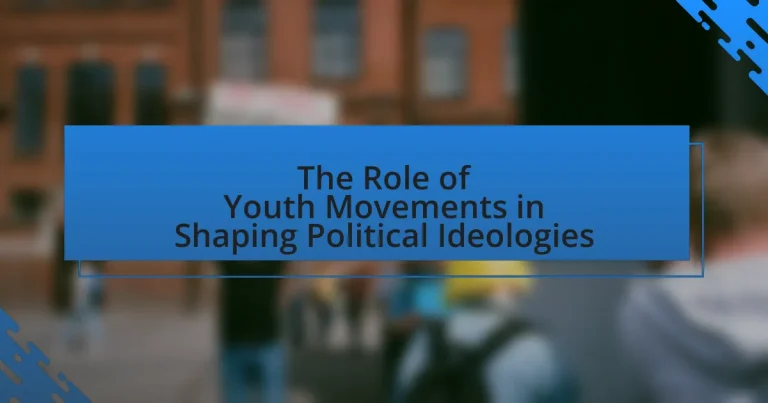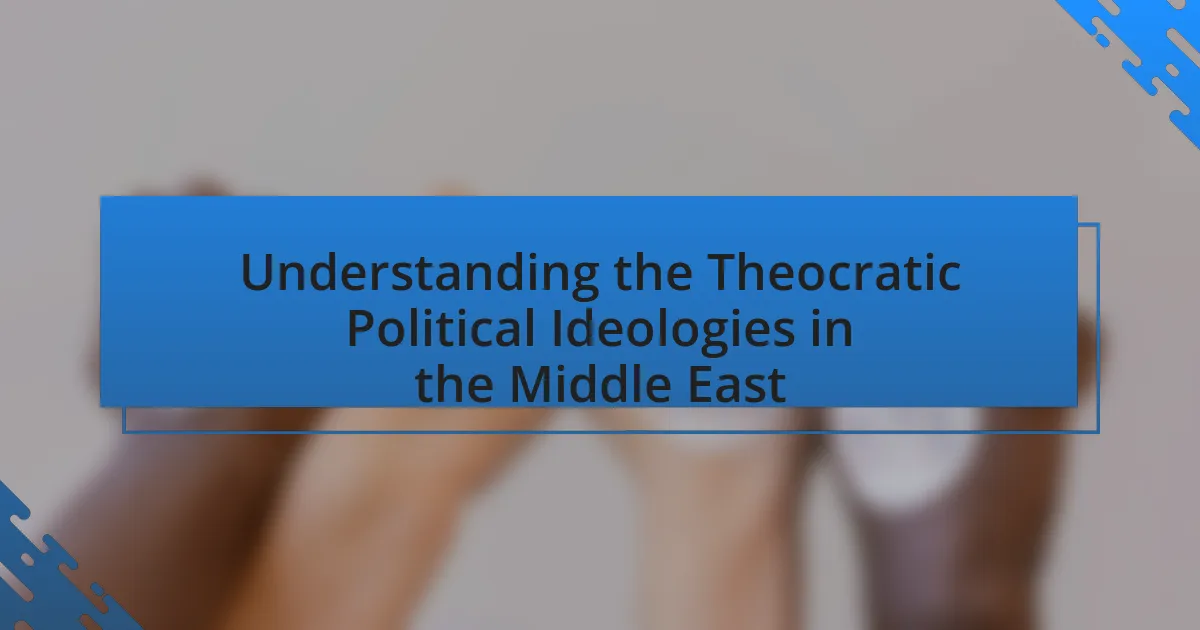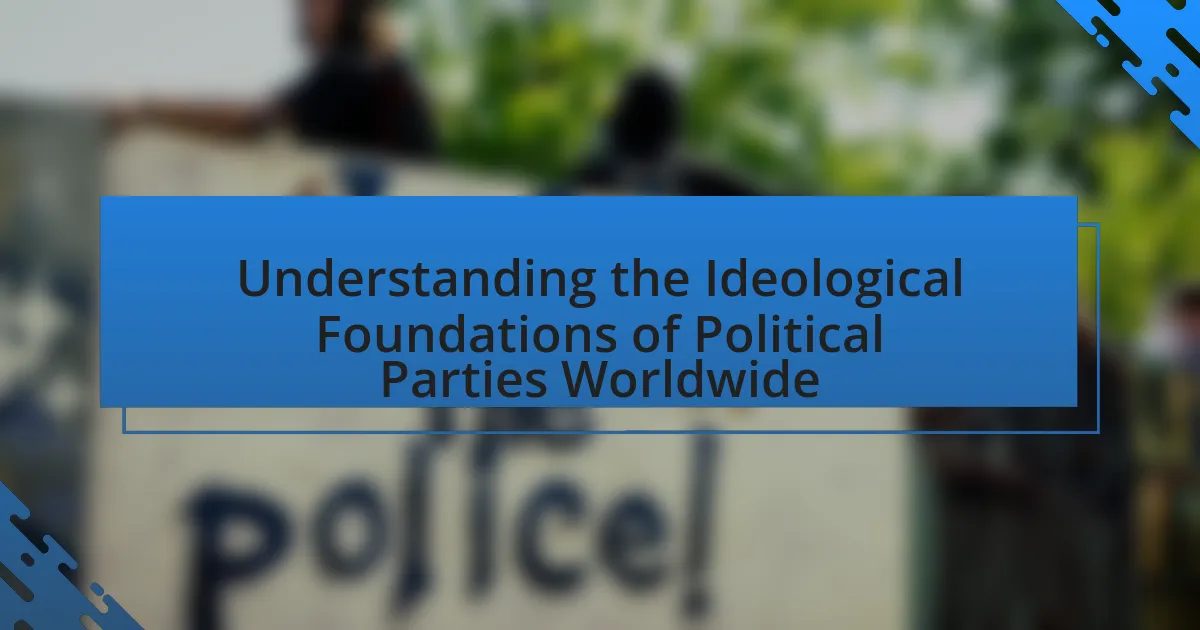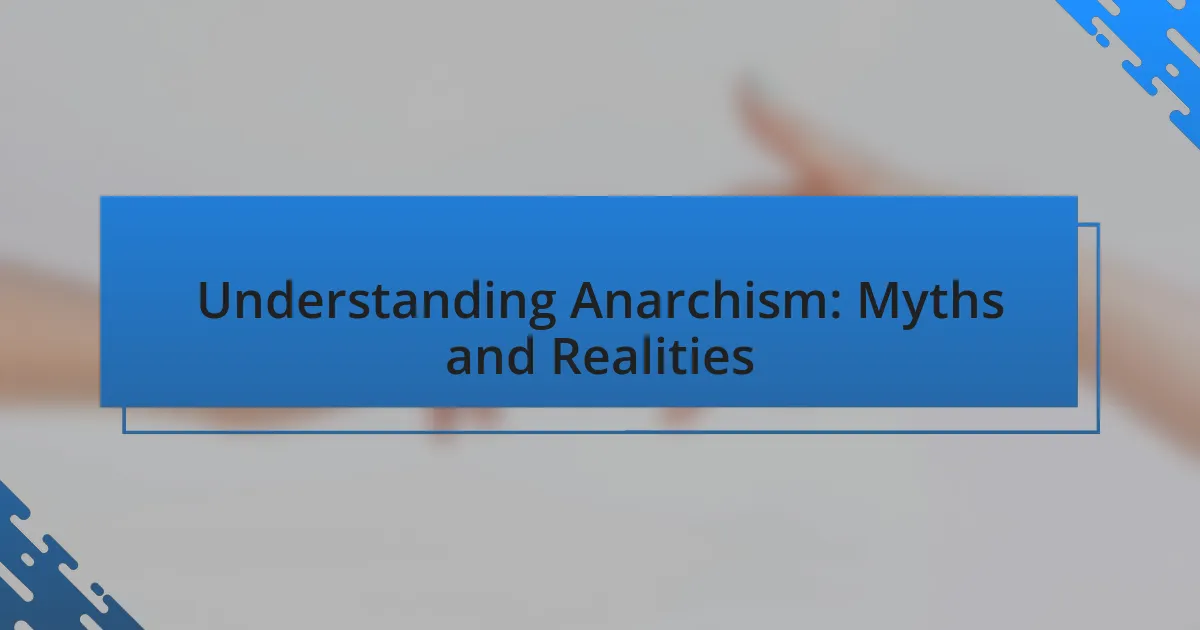Youth movements are pivotal in shaping political ideologies by mobilizing young people around critical issues such as social justice, environmental sustainability, and human rights. These movements influence public discourse and policy, exemplified by initiatives like the global climate strikes led by activists such as Greta Thunberg and the Black Lives Matter movement. Historical examples illustrate how youth activism has transformed political landscapes, while contemporary movements adapt to changing political environments through technology and coalition-building. Despite facing challenges like institutional resistance and resource limitations, youth movements continue to drive significant shifts in political thought and action, reflecting the values and priorities of younger generations.
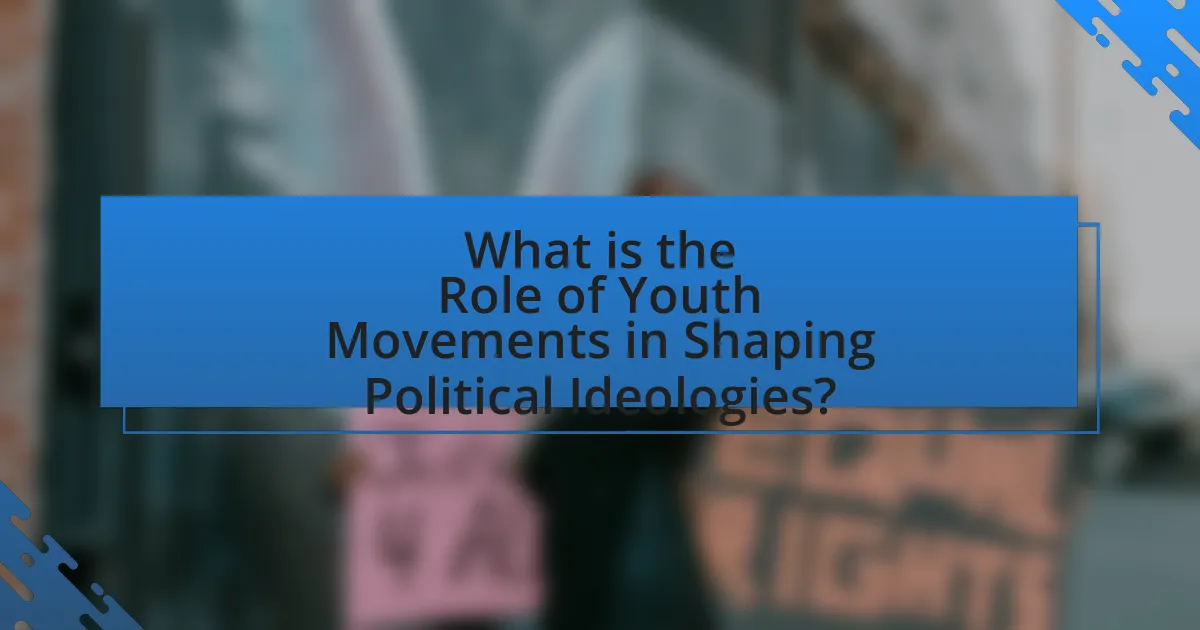
What is the Role of Youth Movements in Shaping Political Ideologies?
Youth movements play a crucial role in shaping political ideologies by mobilizing young people around specific causes and influencing public discourse. These movements often advocate for social change, environmental issues, and human rights, which can lead to the emergence of new political ideologies or the transformation of existing ones. For instance, the global climate strikes initiated by youth activists like Greta Thunberg have significantly raised awareness about climate change and pressured governments to adopt more progressive environmental policies. Historical examples include the civil rights movement in the United States, where young activists were pivotal in challenging racial segregation and promoting equality, thereby reshaping the political landscape. Such movements not only reflect the values and aspirations of younger generations but also serve as catalysts for broader societal change, demonstrating their impact on political ideologies.
How do youth movements influence political thought and action?
Youth movements significantly influence political thought and action by mobilizing young people around specific issues, thereby shaping public discourse and policy. These movements often advocate for social justice, environmental sustainability, and political reform, which resonate with the values and concerns of younger generations. For instance, the global climate strikes initiated by youth activists like Greta Thunberg have raised awareness about climate change and pressured governments to adopt more aggressive environmental policies. Additionally, research indicates that youth-led movements, such as Black Lives Matter, have transformed conversations around racial equality and police reform, leading to legislative changes in various jurisdictions. Through social media and grassroots organizing, youth movements amplify their messages, engage a broader audience, and foster a sense of community, ultimately driving political engagement and action.
What historical examples illustrate the impact of youth movements on political ideologies?
Youth movements have significantly influenced political ideologies throughout history, with notable examples including the 1960s counterculture movement in the United States and the May 1968 protests in France. The counterculture movement challenged traditional values and promoted civil rights, anti-war sentiments, and environmentalism, leading to a shift in American political discourse towards progressive ideologies. Similarly, the May 1968 protests in France, driven by students and workers, called for social and political reforms, ultimately contributing to a reevaluation of authority and the establishment of leftist ideologies in French politics. These movements exemplify how youth activism can reshape political landscapes and ideologies by mobilizing collective action and challenging the status quo.
How do youth movements adapt to changing political landscapes?
Youth movements adapt to changing political landscapes by leveraging technology, forming coalitions, and shifting their messaging to resonate with current issues. For instance, the rise of social media has enabled youth movements to mobilize quickly and effectively, as seen in the Arab Spring, where platforms like Twitter and Facebook facilitated rapid organization and communication among young activists. Additionally, these movements often collaborate with other social and political groups to amplify their impact, as demonstrated by the intersectionality seen in movements like Black Lives Matter, which incorporates various social justice issues. By continuously evolving their strategies and focusing on relevant topics, youth movements remain influential in shaping political ideologies and responding to the dynamics of the political environment.
Why are youth movements significant in contemporary politics?
Youth movements are significant in contemporary politics because they drive social change and influence policy decisions. These movements often mobilize young people around issues such as climate change, racial justice, and education reform, reflecting the values and priorities of the younger generation. For instance, the global climate strikes initiated by youth activists like Greta Thunberg have raised awareness and pressured governments to adopt more sustainable policies. Additionally, studies show that youth engagement in political movements can lead to increased voter turnout and participation in democratic processes, as seen in the 2020 U.S. elections where young voters played a crucial role in shaping the outcome.
What unique perspectives do young people bring to political discourse?
Young people bring fresh, innovative perspectives to political discourse, often characterized by their emphasis on social justice, environmental sustainability, and inclusivity. Their engagement is frequently driven by a desire for systemic change, as evidenced by movements like Fridays for Future, which highlights climate change urgency and mobilizes youth globally. Additionally, young individuals often leverage digital platforms to amplify their voices, facilitating rapid information dissemination and fostering community engagement. This digital savviness allows them to challenge traditional political narratives and advocate for policies that reflect their values, such as equity and diversity. Research indicates that youth participation in political movements can significantly influence policy discussions, as seen in the increased attention to issues like gun control and climate action following youth-led initiatives.
How do youth movements challenge traditional political structures?
Youth movements challenge traditional political structures by mobilizing young people to advocate for progressive change, often bypassing established political channels. These movements leverage social media to amplify their messages, engage in grassroots organizing, and create alternative platforms for political discourse. For instance, the global climate strikes led by youth activists like Greta Thunberg have pressured governments to address climate change more urgently, demonstrating the power of youth-led initiatives to influence policy. Additionally, movements such as Black Lives Matter have reshaped conversations around systemic racism and police reform, highlighting the ability of youth to redefine political priorities and challenge the status quo.
What are the key characteristics of effective youth movements?
Effective youth movements are characterized by strong leadership, clear goals, inclusivity, and the ability to mobilize and engage participants. Strong leadership provides direction and inspires commitment, while clear goals ensure that the movement has a focused agenda, such as advocating for social justice or environmental sustainability. Inclusivity fosters a diverse membership, allowing for a range of perspectives and ideas, which enhances creativity and problem-solving. The ability to mobilize participants is crucial, as it enables the movement to organize events, campaigns, and protests effectively, thereby amplifying their message and impact. Historical examples, such as the Civil Rights Movement in the United States, demonstrate how these characteristics can lead to significant societal change.
What strategies do successful youth movements employ to mobilize support?
Successful youth movements employ strategies such as leveraging social media, grassroots organizing, and coalition-building to mobilize support. Social media platforms enable these movements to reach a wide audience quickly, facilitating the dissemination of their messages and calls to action. For instance, the #FridaysForFuture movement effectively utilized Twitter and Instagram to engage millions of young people globally, raising awareness about climate change and mobilizing them for protests. Grassroots organizing involves engaging local communities through events and direct outreach, which fosters a sense of belonging and urgency among supporters. Additionally, coalition-building with other organizations amplifies their reach and resources, as seen in the collaboration between youth climate activists and established environmental groups, enhancing their collective impact. These strategies are validated by the significant participation rates and media coverage achieved by movements like Black Lives Matter and March for Our Lives, demonstrating their effectiveness in mobilizing support.
How do youth movements utilize social media to amplify their message?
Youth movements utilize social media to amplify their message by leveraging platforms to reach a broader audience and engage in real-time communication. These movements create viral content, such as hashtags and videos, that resonate with their target demographic, facilitating rapid dissemination of their ideas. For instance, the #BlackLivesMatter movement effectively used Twitter and Instagram to mobilize support and raise awareness about racial injustice, resulting in global protests and discussions. Research indicates that 79% of young people believe social media is an effective tool for political engagement, highlighting its significance in shaping public discourse and influencing political ideologies.
How do youth movements interact with established political parties?
Youth movements interact with established political parties primarily through advocacy, collaboration, and sometimes confrontation. These interactions often manifest as youth-led campaigns that influence party platforms, mobilize voter bases, and push for policy changes aligned with the interests of younger demographics. For instance, the rise of climate activism among youth has pressured political parties to adopt more aggressive environmental policies, as seen in the Green New Deal initiatives supported by various parties in the United States. Additionally, youth movements frequently engage in grassroots organizing, which can lead to formal partnerships with political parties during elections, enhancing the visibility and relevance of youth issues in political discourse.
What role do youth movements play in party platforms and policies?
Youth movements significantly influence party platforms and policies by advocating for issues that resonate with younger demographics, such as climate change, social justice, and education reform. These movements mobilize young voters, compelling political parties to adopt progressive stances to attract this critical voting bloc. For instance, the rise of the Sunrise Movement in the United States has pushed the Democratic Party to prioritize the Green New Deal, reflecting the urgency of climate action demanded by younger activists. Additionally, youth movements often utilize social media to amplify their messages, creating pressure on political parties to respond to their demands or risk losing electoral support. This dynamic illustrates how youth movements serve as catalysts for policy change, shaping the political landscape to align with the values and priorities of younger generations.
How can youth movements influence party leadership and direction?
Youth movements can significantly influence party leadership and direction by mobilizing young voters, advocating for progressive policies, and challenging established norms within political parties. These movements often bring fresh perspectives and priorities that resonate with younger demographics, compelling party leaders to adapt their platforms to remain relevant. For instance, the rise of climate activism among youth has led many political parties to prioritize environmental policies, as seen in the Green New Deal initiatives in the United States, which gained traction due to youth advocacy. Additionally, youth movements utilize social media to amplify their messages, creating pressure on party leadership to respond to their demands, as evidenced by the global impact of movements like Fridays for Future. This dynamic illustrates how youth movements can reshape party agendas and leadership approaches to align with contemporary societal values.
What challenges do youth movements face in shaping political ideologies?
Youth movements face significant challenges in shaping political ideologies, primarily due to institutional resistance, generational divides, and resource limitations. Institutional resistance often manifests in the form of established political entities that may dismiss or undermine the perspectives of younger activists, as seen in various global contexts where youth-led initiatives struggle for recognition. Generational divides can create barriers to communication and understanding between youth and older political leaders, leading to a lack of alignment on key issues. Additionally, resource limitations, including funding and access to platforms for advocacy, hinder the ability of youth movements to effectively mobilize and influence political discourse. These challenges collectively impede the capacity of youth movements to enact meaningful change in political ideologies.
How do societal and institutional barriers impact youth activism?
Societal and institutional barriers significantly hinder youth activism by limiting access to resources, platforms, and decision-making processes. These barriers manifest in various forms, such as age discrimination, lack of representation in political structures, and inadequate support from educational institutions. For instance, a study by the Pew Research Center found that young people often feel marginalized in political discussions, which diminishes their ability to influence policies that affect their lives. Additionally, institutional policies may restrict youth participation in protests or civic engagement activities, further stifling their voices. This combination of societal attitudes and institutional limitations creates an environment where youth activism struggles to thrive, ultimately affecting the broader political landscape.
What strategies can youth movements employ to overcome these challenges?
Youth movements can employ strategies such as grassroots organizing, digital mobilization, and coalition-building to overcome challenges. Grassroots organizing allows youth to engage directly with their communities, fostering local support and addressing specific issues. Digital mobilization leverages social media platforms to reach a wider audience quickly, facilitating rapid information dissemination and engagement. Coalition-building with other organizations enhances resources and amplifies voices, creating a united front that can more effectively advocate for change. These strategies have been proven effective in various movements, such as the Arab Spring, where youth utilized social media to mobilize protests and raise awareness on a global scale.
What future trends can we expect from youth movements in politics?
Future trends in youth movements in politics will likely include increased digital activism, greater emphasis on climate change, and a focus on social justice issues. Digital platforms enable youth to mobilize quickly and effectively, as seen in movements like Fridays for Future, which has galvanized millions globally around environmental concerns. Additionally, the urgency of climate change is prompting younger generations to demand policy changes, influencing political agendas and party platforms. Social justice movements, such as Black Lives Matter, demonstrate how youth are prioritizing equity and inclusion, shaping political discourse and legislative priorities. These trends indicate that youth movements will continue to play a pivotal role in redefining political ideologies and driving systemic change.
How might emerging technologies influence youth political engagement?
Emerging technologies significantly influence youth political engagement by facilitating access to information and enabling real-time communication. Social media platforms, for instance, allow young people to share ideas, mobilize for causes, and participate in discussions, which can lead to increased political awareness and activism. According to a 2020 study by the Pew Research Center, 55% of young adults reported that social media is a key source of political news, highlighting its role in shaping political opinions and behaviors. Additionally, tools like online petitions and crowdfunding platforms empower youth to organize and support political movements more effectively, demonstrating the transformative impact of technology on their engagement in political processes.
What potential shifts in political ideologies could arise from youth movements?
Youth movements could lead to significant shifts in political ideologies by promoting progressive values such as social justice, environmental sustainability, and inclusivity. These movements often challenge traditional political structures and advocate for reforms that reflect the priorities of younger generations, such as climate action and equitable economic policies. For instance, the global climate strikes initiated by youth activists like Greta Thunberg have galvanized support for environmental policies across various political landscapes, pushing parties to adopt greener platforms. Additionally, movements advocating for racial and gender equality have reshaped discussions around identity politics, influencing mainstream political discourse and leading to the emergence of new political parties or coalitions that prioritize these issues.
What practical steps can young activists take to enhance their impact?
Young activists can enhance their impact by organizing community events to raise awareness about social issues. These events, such as workshops, rallies, or informational sessions, create platforms for dialogue and education, fostering a sense of community engagement. Research indicates that grassroots movements, like the March for Our Lives, effectively mobilized youth around gun control, demonstrating that collective action can lead to significant policy discussions and changes. By leveraging social media to amplify their messages, young activists can reach wider audiences, as seen in the global response to climate change initiatives led by youth. Engaging in local politics, such as attending town hall meetings or advocating for policy changes, further solidifies their influence in shaping political ideologies.
